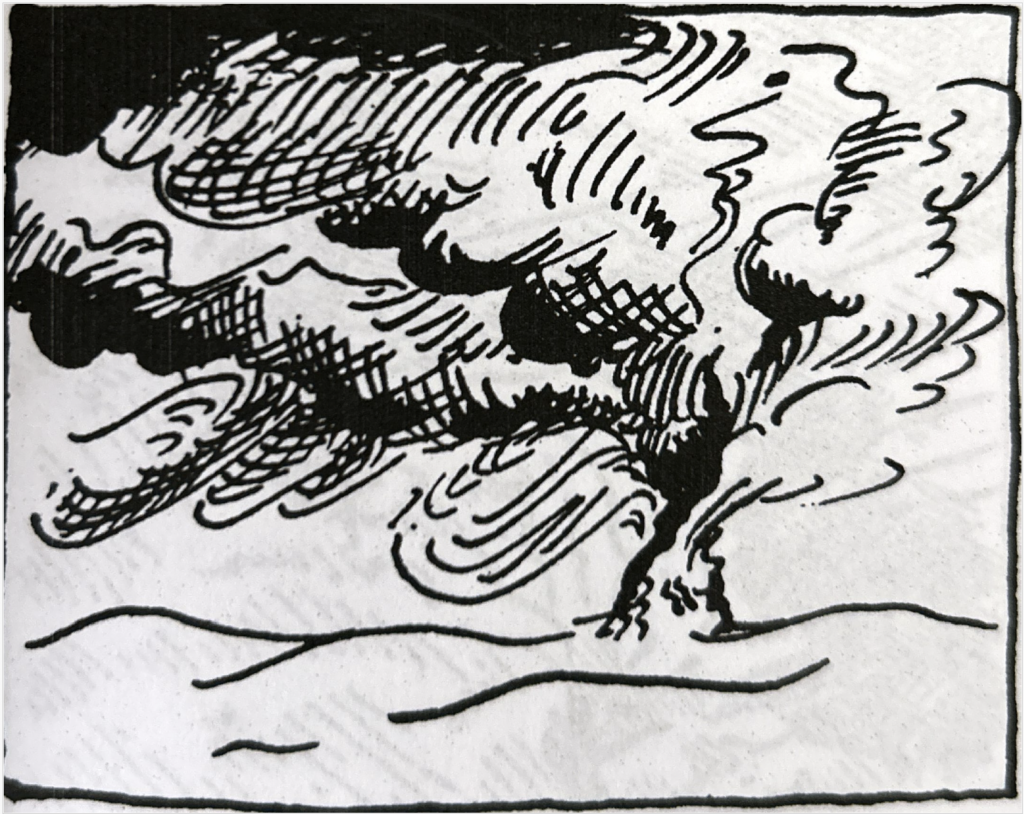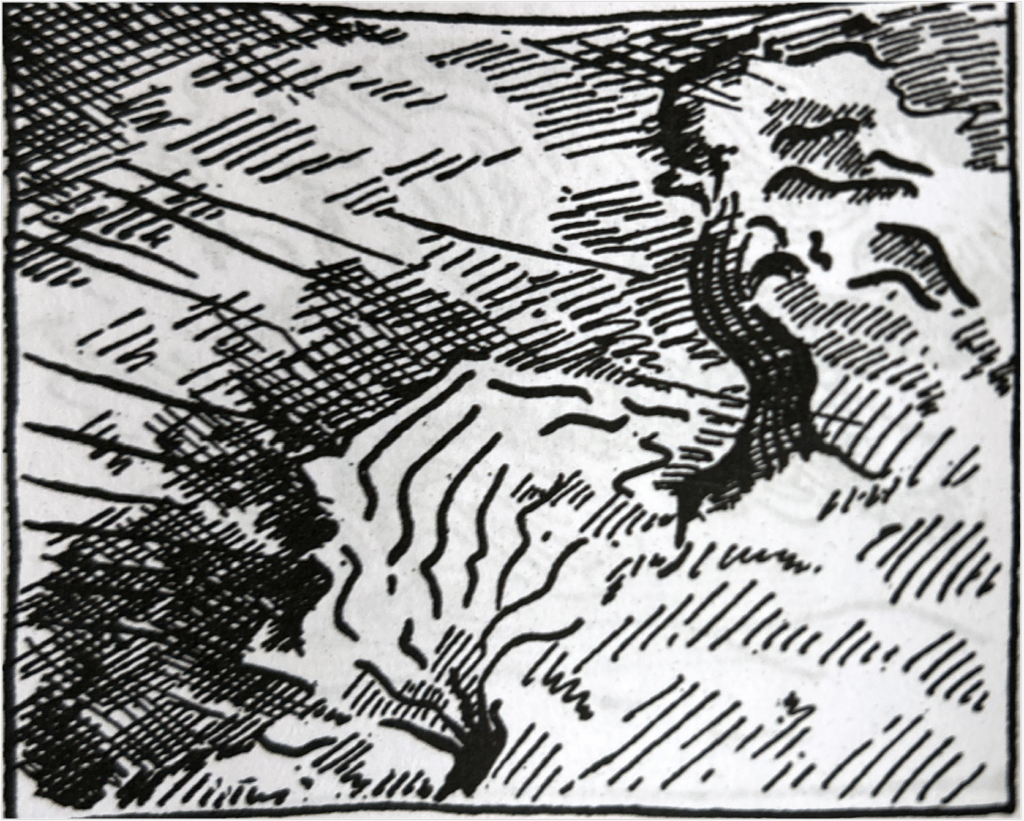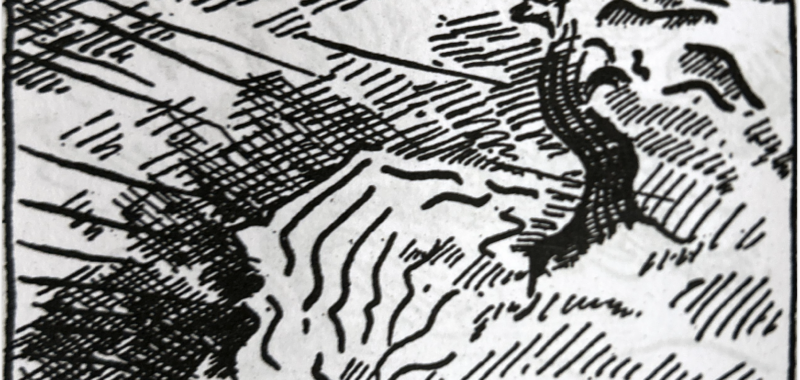Marion Milner, The Angry Parrot. All images from Marion Milner’s On Not Being Able to Paint (Routledge, 2010), reproduced by permission of Taylor and Francis Group.
“Before the problem of the creative artist,” Freud famously declared in an essay on Russian literature, “analysis must, alas, lay down its arms.” Our creative potential—as it is expressed in the most ordinary dream or jokes, or in the extraordinary compositions of great artists—has always been a vital theme in psychoanalysis, but it has also been an elusive one. Freud himself, although he was interested in art and literature, knew he was better at diagnosing sources of suffering than sources of inspiration. People in mental pain, whether from depression, obsession, or panic attacks, may present similar symptoms, but everyone is creative in her own way. Creativity is difficult enough to describe, let alone prescribe.
Born in London in 1900, Marion Milner was part of a group of British psychoanalysts who put creativity at the center of their theory and practice. Her friend and colleague D. W. Winnicott, for instance, considered it the analyst’s role to encourage patients’ capacity for creative and playful living, rather than to interpret the hidden meanings of their psyche. Another member of this group, the extraordinarily learned Masud Khan, insisted on the relevance of literature to any psychological knowledge. What makes Milner distinctive, however, is that she approached her therapeutic project by way of her own creative explorations in literature and visual art. She began her career as a writer and an amateur artist while working a more conventional day job as an industrial and educational psychologist, and she did not train in Freudian psychoanalysis until she was well into midlife. But it was by bringing the perspective of the creative artist to her practice of psychoanalysis (and not the other way around) that she came to offer lasting insight.
Milner’s earliest writings stem from her feeling, as she put it in her first book, that she was—despite her cultured life, promising career, and many friends—“shut away from whatever might be real in living.” She responded by way of an “experiment” in finding a “way by which each person could find out for himself what he was like, not by reading what other people thought he ought to be, but directly, as directly as knowing the sky is blue and how an apple tastes, not needing anyone to tell him.”
Since 1926, Milner had been writing diaries in which she recorded her impressions of life in ways that seem ordinary enough. She would, for example, note seeing “a little boy in a sailor suit dancing and skipping by himself on his way to look at the sea lions,” or reflect, “I realized how untrustworthy I am in personal relationships … always agreeing with the person present.” But in the thirties Milner turned her diaries, as a sort of raw material, into her first books, which were published as essayistic reflections about her diaries: A Life of One’s Own (1934) and An Experiment in Leisure (1937). In them she invented something new and a genre of her own: a diary about a diary, or what the critic Hugh Haughton has called a “meta-diary.” Contemporaries like W. H. Auden responded with enthusiasm.
In these books, Milner begins her experiments in a familiar idiom of self-help. She attempts to list her life’s ambitions (today we might call this process “manifesting”) only to discover that, upon articulation, her goals inevitably devolve into “Sunday paperish” clichés like “plumbing the depths of human experience” or “drinking life to the dregs.” Not only are these amorphous aims impossible to accomplish, but Milner is “rather puzzled to find that the straightforward statement of the facts” of what matters to her “completely destroyed all sense of its importance.” What is remarkable about Milner’s writing—and makes it, I think, a landmark in the literature of self-discovery—is that it possesses the courage of its lack of convictions.
Abandoning her prefabricated aims for the future, Milner’s meta-diaries turn instead to the wayward movement of her thoughts in the present. She experiments with a kind of free writing, abandoning herself to the randomness of unplanned associative thought: “Whenever I felt the clutch of anxiety … whenever I felt a flood of inferiority lest I should never be able to reach the good I was aiming at, I tried a ritual sacrifice of all my plans and strivings.” Attending now to the thoughts that come when she is not directing her mind, Milner is startled to discover them leading her to preoccupations she never knew she had. “Led by a curious remote sense of intimacy” in certain “scrappy observations,” she follows chains of association to fantastic, gothic visions, which call to mind “Pan, the Devil, the elder gods, fertility rites, dark ceremonies in forests.” Milner comments, “These tricks of my imagination puzzled me … I was not given to dreaming of fabulous happenings, I had not read fairy tales for years and stories of fantasy written for adults rather bored me. But it seemed I only had to scratch the surface of my thinking in order to slip through to mythological levels.” In the process, she begins to wonder if she is a different sort of person than she had thought: someone with a “darker instinct.” But if this were so, then what, Milner wonders,
was I to do about it? The implications seemed a little awkward. Was I to hunt for a present-day company of devil worshippers and join their ranks? But I knew by the sense of intimacy in all these ideas that it was not a matter to be put lightly aside; if I had set out determined to find the meaning of what was most interesting, then I must face this question.
It is in wondering, with a kind of earnest irony, why she doesn’t become a Satanist that Milner makes progress. If devil worshippers know one thing, it is to whom they are paying their addresses. The very tone of Milner’s writing, on the other hand—a combination of the cheerfully brisk and practical with an openness to truly strange and eccentric experience (she sometimes sounds like Alice in Wonderland)—derives from her commitment to tolerating her own more dark or violent affects without too quickly resolving or explaining them through an external authority.
Indeed, it is for the same reasons she does not become a “devil worshipper,” Milner notes, that she does not become an academic. Of her fascination with mythologies and rituals, she remarks, “At one point I had taken the interest quite literally and seriously thought of becoming an anthropologist … But I was learning now not to be quite so simple-minded about interests.” If she is to find her sense of “what is real in living,” then she needs to find not some particular facts or data about life but expertise in how she handles, and allows to herself to be led by, her own unwitting preoccupations. She finds they lead her to moods and horizons: orientations in which “new possibilities” are “lit up.” Her diary books are close descriptions of this leading and the mental movements by which she finds her interest shifting “from what to do with my life to how to look at it.” She turns from following psychological guides to life to the more ambiguous lessons of art and literature (her diaries are full of literary quotation) and invents a practice of reading as a way of making something, not only learning something. Through this process, Milner becomes determined to collect a personal repertoire of images and texts—a repertoire opposed to conformity with what she calls the “mass-produced” desires and images of advertising, political propaganda, and Hollywood.
***

Marion Milner, Summer Morning.
In seeking images that mean something to her, Milner widens the media in which she conducts her search. In 1950 she describes “a most surprising discovery”:
that it was possible at times to produce drawings or sketches in an entirely different way … of letting hand and eye do exactly what pleased them without any conscious working to a preconceived intention. This discovery had at first been so disconcerting that I had tried to forget all about it … it threatened one’s sense of oneself as a more or less known entity.”
Milner turns from looking at her written diaries to the records of some doodles she had made to accompany them. She had not found them, or had not wanted to find them, significant before; now she finds in the borderline of word and image a new arena for describing her experience of boundaries—between self and other, the mind and body, the body and the world—and for imagining how those boundaries might be negotiated. She is compelled to understand her experiments in drawing and painting as a form of “visual reflection on the basic problems of living,” which are “intimately connected … with the problems of creativity and creative process.” It is the visual exploration of these “basic problems,” by which she means nothing less than learning how to be in the world, in vital and creative relation to it, that leads her to what became in her lifetime her best-known book, On Not Being Able to Paint.
Like her earlier meta-diaries, this book, published in 1950, records her drawings—both from much earlier in her life and those produced over the course of writing the book—as well as her commentary on them. She frames the book as a story of what happened when she attempted to teach herself drawing from scratch. She finds not only that her more purposeful, representative attempts at art fail at realism, but that their failures contain hints and gleams of other interests of which she had been unaware. She attempts a peaceful scene of trees on the South Downs of Sussex, for example, only to find in its unruly lines a blazing heath fire, while an expansive beech tree as she draws it becomes, through her surprisingly cramped and aggressive lines, more like a “snowy crag, blasted by a raging storm.”
Milner had not meant the lines of her sketch to veer away from what they were supposed to represent. But drawings inadequate to their conscious purposes are revealed to express unthought emotion. In following the thread of this discovery, On Not Being Able to Paint takes as its subject drawings that are ever more abstract and associative. From the marks her hand makes on the paper, Milner realizes her inner life is refracting her sensible perception of the outer world more powerfully than she had imagined was possible: “Surely it was a very active and headstrong kind of reflection, it could apparently elaborate on its external prototype as freely as Alice’s ‘Through the Looking Glass’ world did.” Her sketches are revealed to be portals to another world: signs taken for Wonderland.

Marion Milner, Summer Beeches.
***
On Not Being Able to Paint cannot really be summarized: the path—and prose—by which Milner leads her reader through her exploration of mark-making is inextricable from the book’s psychological insight. One has to read it for oneself. But it is possible to trace the book’s influence on the distinctive therapeutic practice through which Milner helped her patients as well as herself. A good example is found in the case of “Simon,” a boy of eleven who had been “remarkably interested and successful” at school between the ages of four and six but was now unhappy and “at times totally unable to get himself to school at all.” From the toys in Milner’s consulting room, Simon created a game in which “all the toys had been set out in the form of a village, full of people and animals; the boy would then bomb the village by dropping balls of burning paper upon it, my role being to play the part of the villagers, and try to save all the toys from actual destruction. The rules of the game were such that this was often very difficult.”
At first Milner tries to explain Simon’s play and his setting her to a demoralizing task as his attempt to compensate for the disempowerment of children by parents. Simon, she notes, had lived through the Blitz—so the mastering of a historical trauma is also at stake. “When talking to me,” Milner records in her 1952 paper on the case, “The Role of Illusion in Symbol Formation,” he adopted a “particularly bullying tone.” Whether it is his father or the Führer who is in the background here, Simon appears to want to be the one to try on what Milner calls the “dictatorship attitude” for once.
The problem is that Milner’s interpretations are no use. They keep her in a relation of competition with Simon about who is in the right and who has the upper hand. In response, Simon’s “aggression did not seem to lessen and I was sometimes in despair at its quite implacable quality.” Milner comes to wonder if her attention to explaining Simon’s play has blinded her to seeing it as the practice of a creative art, with toys as the medium, just as paper and ink had been her own. Attending to Simon’s play in this way, says Milner, raises “the whole question of beauty appearing in analysis,” a subject that had until then “not been much discussed” in psychoanalytic writing. Milner goes on:
In trying to understand all that this boy was trying to show me I had to take into account the fact that at times there was a quality to his play that I can only describe as beautiful—occasions where it was he who did the stage managing and it was my imagination that caught fire. It was in fact play with light and fire. He would close the shutters of the room and insist that it be lit only by candle light, sometimes a dozen candles arranged in patterns, or all grouped together in a solid block … In fact, all this type of play had a dramatic ritual quality … And this effect was all the more striking because this boy’s conscious interests were entirely conventional for his age; he was absorbed in Meccano and model railways.
In inventing such rituals, Simon is making the images and mythologies he needs. His playing with fire is here not a symbol for something else. It is just that: playing with fire. Milner holds off analysis for a moment in order to appreciate Simon’s creativity. In doing so, she comes to understand therapeutic practice as not only a task of interpretation, but the provision of a designated time—a medium—for everyday art. This understanding proves of use to Simon, who changes his mode of relation to Milner, becoming absorbed instead of captious. She helps Simon toward the same process she had come to value for herself: that “dialogue” between thought and “chalk, charcoal, paint.”
It is in finding his way to a creative use of the world around him, Milner comments, that Simon becomes able to keep his sense of the future alive. He goes back to school and is able to learn again. (He would become a distinguished scientist.) “I think that it is significant,” says Milner, “that, near the end of his analysis, this boy told me … he would give me a papier-mâché chemical clock,” and she suggests that “the malleability of the papier-mâché provided him with a way of expressing how he felt about part of the curative factor in his analysis.” Only through his practice of creative expression could he come to “accept the real qualities of externality, objective time standing as the chief representative of these.” Her writings show us how our feeling for the future is maintained through (as she puts it in another paper) our “sensual experience.” Milner found psychoanalytic writing familiar with painful inhibition. She wanted to make room in it for creative exultation too—what she called “the yell of joy.”
David Russell is associate professor of English at the University of California, Los Angeles, where he teaches nineteenth and twentieth-century literature, and on the essay, the history of criticism, and psychoanalysis. He is the author of Tact: Aesthetic Liberalism and the Essay Form in Nineteenth-Century Britain and of Marion Milner: On Creativity, forthcoming in June 2024.

